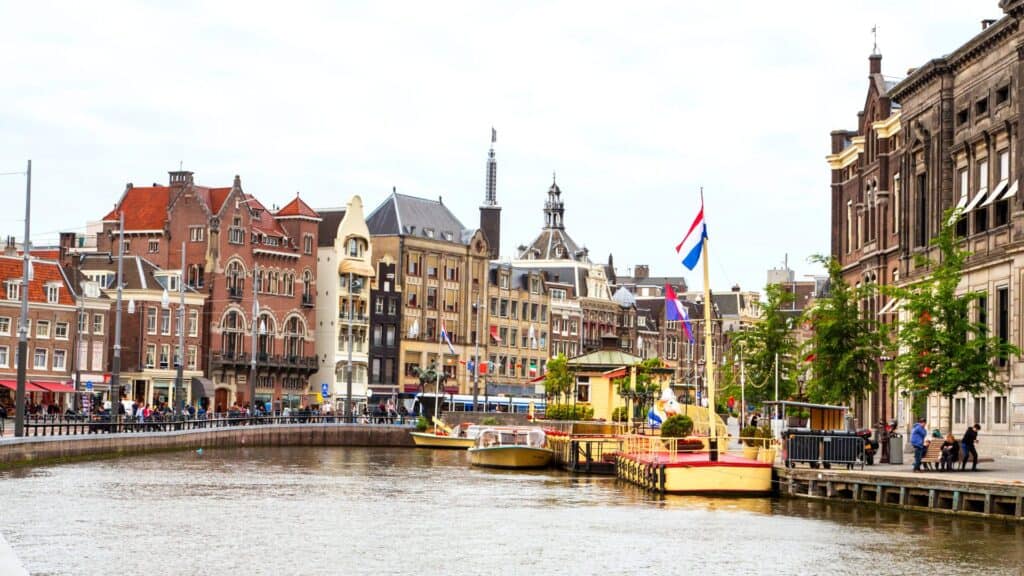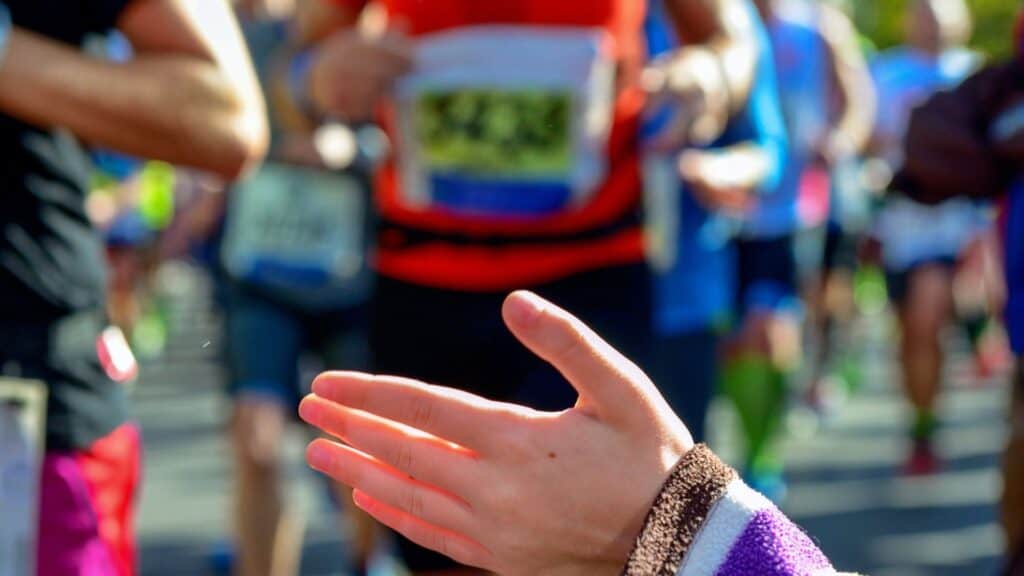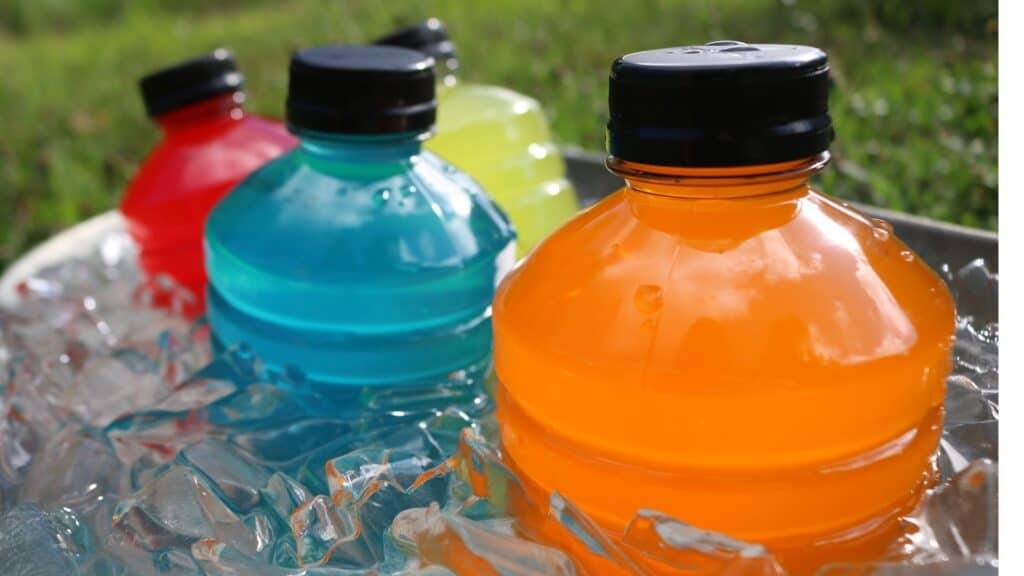The Amsterdam Marathon: a challenging race that tests your endurance, and mental toughness, and celebrates the human spirit.
When runners from all over the world come to Amsterdam, they’re in for a demanding race that requires them to be at their best physically.
And nutrition plays a huge role in doing well in a marathon. Whether you’re a seasoned runner or it’s your first time taking on the 42.2 km (26.2 miles), understanding how to fuel for and during the race is of paramount importance.
In this guide, we’ll take you through a fueling tour of the Amsterdam Marathon, looking at what you can find to eat along the way, how to fuel up properly, and the important steps to recover after the race so you feel great for days to come.

Please note that event details, including nutrition options, may change from year to year due to sponsorship and logistics. To stay up-to-date, we recommend checking the official Amsterdam Marathon website for the latest information.
Here’s What You’ll Find Along The Amsterdam Marathon Route
The Amsterdam Marathon course is not just about running; it’s a chance to explore the heart of this vibrant city. As you take on the 42.2-km (26.2-mile) route, you’ll come across carefully positioned aid stations meant to keep you energized and well-hydrated.
Let’s take a closer look at what you can expect along the way:
Water and Sponge Stations: Hydration is key, and you’ll find water and sponge stations at several points along the route, including the 5K (3.1 miles), 11.5K (7.1 miles), 15.5K (9.6 miles), 20K (12.4 miles), 26K (16.2 miles), 31K (19.3 miles), 33K (20.5 miles), 35K (21.7 miles), 38.5K (23.9 miles), and 40.5K (25.2 miles) markers, as well as at the finish line.
These stations are a lifeline for runners, offering water to quench your thirst and sponges to cool you down.
Remember to stay hydrated but don’t overdo it, as excessive water consumption can lead to discomfort.
AA Drink Iso Lemon: At select stations, you’ll encounter AA Drink Iso Lemon, a specially formulated sports energy drink designed to help you maintain your fluid and energy balance during the race.
Packed with essential vitamins like B3, E, B5, B6, and H, this drink not only keeps you hydrated but also supports your immune system and metabolism.
You’ll receive AA Drink Iso Lemon in convenient 0.15L (5.1 fluid oz) cups during the race and a refreshing 0.33L (11.1 fluid oz) bottle at the finish line.
Bananas: Alongside AA Drink Iso Lemon, you can refuel with bananas available at select stations.
Bananas provide a quick source of energy and are rich in potassium.
Note: Do Bananas REALLY Prevent Leg Cramps While Running
Restroom Facilities and First-Aid Services: These stations aren’t just about food and drinks; they also offer restroom facilities and first-aid services, ensuring you have everything you need to stay comfortable and safe during the race.
When it comes to nutrition during the Amsterdam Marathon, having your own plan is crucial to meet your unique needs and boost your performance.
Sticking to what you’ve practiced in training is vital. Avoid trying new things on race day, especially products with caffeine that can affect your digestion.
To have a successful race day, practice and train with your nutrition plan during your long runs leading up to the marathon. This will give you confidence and comfort with your strategy.
How To Fuel For The Amsterdam Marathon
To have a successful fueling experience in the Amsterdam Marathon, your preparation is key. This includes practicing your nutrition and hydration strategies during your training.
Here are some essential steps to make sure your fueling plan is well-tested and ready for the big race day:
The Week Before The Marathon
In the week leading up to the marathon, focus on the following:
- Stay Hydrated. Keep yourself well-hydrated.
- Carbohydrate Intake. Ensure you’re eating enough carbohydrates. There’s no need for extreme “carboloading.” Just maintain your regular healthy carbohydrate intake.
- Fiber Reduction. To minimize the risk of digestive issues during the race, reduce your fiber intake for 2-3 days before the marathon.
- Tapering. Decrease your training volume during the taper week to help fill your glycogen stores.
The Night Before The Marathon
The evening before the Amsterdam Marathon, ensure you check these items off your nutrition checklist:
- Breakfast Timing. Plan to have breakfast approximately two hours before the race.
- Pre-Race Snack. Pack a pre-race snack and a water bottle to maintain your energy levels while waiting in your starting corral.
- Organize Nutrition. Lay out your race nutrition items like gels, bars, sports drinks, and rehydration solutions. This makes it easier to fuel during the race.
- Hydration. Stay well-hydrated, but avoid alcohol as it can dehydrate your body.
The Morning Before Before The Marathon: Your Breakfast
It’s essential to have your breakfast approximately two hours before the Amsterdam Marathon.
While it might not entirely eliminate the risk of hitting the dreaded “wall,” it can certainly postpone its onset.
When planning your pre-race breakfast, choose foods that are low in fat and fiber to minimize the likelihood of digestive problems during the race.
Consistency is key, so stick to the same nutrition choices you’ve successfully consumed during your training to steer clear of any unexpected issues on race day.
Here are some suitable breakfast options before running a marathon:
- Oats. Oats are an excellent choice because they provide complex carbohydrates for sustained energy without causing digestive issues.
- Pancakes with fruit. Pancakes offer easily digestible carbs, and fruits add natural sugars for a quick energy boost.
- Granola with milk. Granola provides a mix of carbs and healthy fats, while milk adds protein for muscle support.
- Sweetcorn fritters. These fritters are a balanced option with carbs and a touch of protein, ideal for lasting energy.
- Toast with peanut butter. This classic combo offers a balance of carbs and healthy fats, perfect for endurance.
- Banana bread. Banana bread combines carbs from bananas with the comforting energy of baked goods.
- Low-fiber, low-sugar cereal. This cereal type is easy on the stomach and provides straightforward energy.
- Bagels. Bagels are rich in carbs and low in fat, a great foundation for a marathon breakfast.
- English muffins. These muffins are similar to bagels, providing carbs without excess fat.
- Rice cakes. Rice cakes offer easily digestible carbs and can be a gentle option for sensitive stomachs.
Finally, Just Before The Race Starts (About 20-45 Minutes Before)
As the start time approaches, it’s normal to feel a mix of excitement and anxiety.
Since you might have to wait for a while before your corral starts, it’s essential to have some snacks on hand to maintain your energy levels.
Around 15 minutes before the marathon begins, take a moment to sip water from your bottle. Consider consuming a gel or a small portion of an energy bar.
Alternatively, you can sip on an energy drink if gels aren’t your preference. This quick boost of fuel will kickstart your race on the right foot.
With your body properly fueled and hydrated, you’ll be in a better position to face the challenges of the marathon, maintain a steady pace, and push through any moments of fatigue.
The confidence that comes from knowing you’ve taken care of your nutrition can be a valuable mental boost as well.

How Many Gels Should You Consume During The Amsterdam Marathon
During the Amsterdam Marathon, the quantity of gels you should consume can differ depending on your individual requirements and the specific gel products you opt for.
It’s worth mentioning that gels can become excessively sweet, and ingesting an excessive amount can result in nausea.
Typically, it’s advised to target an intake of 30 to 60 grams (1.1 – 2.1 oz) of carbohydrates per hour during the race. Nonetheless, various gel products come with differing carbohydrate contents.
Some might have more carbohydrates or caffeine than others. It’s crucial to examine the carbohydrate content of the gels you intend to utilize and adapt your consumption accordingly.
Variety is essential during a marathon. Eating the same product for 3-6 hours can get boring and might even make you feel uncomfortable.
Your gel intake should be a part of your overall carbohydrate strategy, which can include other sources like energy drinks, bars, or even real foods.
Aim to consume between 30 and 60 grams (1.1 – 2.1 oz) of carbohydrates per hour to keep your energy levels up.
For some runners, depending solely on gels for their carbohydrate intake can be difficult. Including other sources, like energy bars or drinks available along the route, can add variety and help you meet your carbohydrate goals.
In hot weather, it’s essential to drink water alongside your gels to avoid dehydration. Insufficient hydration can lead to nausea and other issues.
So, pay close attention to your fluid intake, especially when running in warmer conditions.
Nausea Before, During, or After Your Run? Here Are 5 Reliable Ways To Prevent It
What Nutrient Would A Marathon Runner Need Most On Race Day?
The most crucial nutrient you need on race day is carbohydrates. Carbs provide glycogen, stored in muscles, which is a vital energy source for peak performance.
Hydration, particularly water, is also essential. Electrolytes may become more or less important depending on environmental conditions. For instance, on a hot day, you might need additional electrolytes. However, it’s a mistake to rely solely on electrolytes without enough carbohydrate intake.
Ultimately, the key takeaway is to practice your race-day nutrition during your training.
Experimenting with different gels, foods, and hydration plans during long training runs will help you optimize your nutrition strategy for the Amsterdam Marathon, enhancing your chances of success on race day.
Lastly, I want to share a brief overview of the Amsterdam Marathon route, so that you have an idea of what’s waiting for you on race day…
Amsterdam Marathon Course Overview
The Amsterdam Marathon Route covers a full 26.2 miles (or 42.2 km for the metric folks) and begins and ends at the historic Olympic Stadium.
A tip for the start: You might be tempted to go full speed ahead in the morning’s coolness, but remember, a marathon is quite a long journey. It’s wise to begin at a sensible pace, preserving your energy for a strong finish. Don’t burn out too early!
Early in the race, you’ll go through Vondelpark, a renowned urban park known for its beauty. The tree-lined paths and tranquil atmosphere make for a pleasant start.
You’ll pass through it twice – once at the beginning, about 2 km (1.2 miles) in, and again on your way back at 40 km (24.9 miles).
Vondelpark is a comforting place when you return, where spectators can offer cheers and that extra motivation to push you towards the finish line.
Around the 4 km (2.5-mile) mark, you’ll pass by the famous Rijksmuseum on Stadhouderskade.
Its stunning architecture and artistry provide a captivating backdrop for your run, allowing you to enjoy some art and history as you go. You’ll pass it again at 38 km (23.6 miles) on your way back.
At the 13 km (8-mile) mark, you’ll encounter a sharp turn at the end of President Kennedylaan.
Leaving the cityscape behind, you’ll follow the scenic Amstel River southward for 5 km (3.1 miles) until you reach Ouderkerk aan de Amstel. Along the way, you’ll spot some windmills and relish the peaceful countryside.
Starting at 14 km (8.7 miles), you’ll run alongside the picturesque Amstel River. This is where you hit a turning point and start heading back.
Keep an eye out for a First Aid point at 16 km (9.9 miles). Just before the first marathoners arrive, there’s also a Mini Marathon.
After the Amstel River segment, the course winds through the Amstel Business Park, featuring lively music, entertainment, and enthusiastic spectators.
However, please note that this part of the course is relatively narrow.

Between the 32 km and 37 km (19.9-23 miles) marks is the most challenging section of the marathon. This is where your cheer squad can make a huge difference!
Heading back to central Amsterdam from the river, you’ll pass through canals, cross old bridges, and go through city parks.
As you near the end, you’ll go under the Wibaustraat at 37 km. People will be cheering as you climb the Torontobrug bridge, heading for Vondelpark.
You’ll find a Polar DJ booth there, playing music to keep you going. A bit later, at 33 km (20.5 miles), there’s the Galileïplantsoen with another Mini Marathon and a First Aid spot.
The marathon rounds at the Olympic Stadium. You’ll finish the 42.2 km (26.2 miles) race with a victory lap around the track.
As you cross the finish line of the Amsterdam Marathon, remember that this race isn’t just about the miles you’ve covered; it’s a celebration of your strength and your determination.
Now, put on those running shoes, enjoy the adventure, and cherish every moment of the Amsterdam Marathon. With a smart nutrition plan, you’ll not only complete the race but also make lasting memories of your marathon day. Here’s to a great run!



Comments are closed.